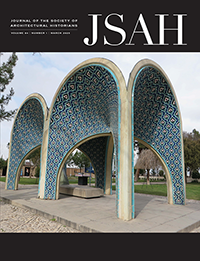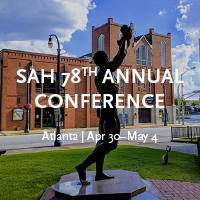During an SAH Member Meetup event on August 13, 2024, SAH President Mohammad Gharipour shared some of his background as an architectural historian and took questions from members about his ideas for SAH's programming, membership, and growth.
Q: Where did your interest in architecture and architectural history begin?
My exposure to architectural history came very early. I was born and raised in Isfahan, Iran, a city with thousands of years of human history. I grew up playing soccer between historic buildings and playing games around the beautiful palaces, mosques, mausoleums, and gardens. Historic architecture was literally my playground.
Q: How have your academic interests evolved over time? What are you studying today?
I am not a conventional architectural historian with a single expertise or focus. I’m highly interactive, as over the years I have worked on many different projects as opportunities arose. I just get excited about something, and I pivot to work on that topic.
My Master’s thesis was on Japanese architecture. Later, I studied the evolution of architectural elements and their interactions with the elements of landscape in Persian gardens throughout history.
Nearly ten years ago, the community members of the Jewish quarters of Isfahan took an interest in documenting their synagogues. Supported by the National Endowment for Humanities and working with a team of local researchers, I surveyed and documented every single synagogue in my hometown. That was a great pleasure.
I also have interests in the intersections of health and architecture and have worked on projects with the National Institutes of Health. That's an area that keeps me excited as it makes me feel relevant.
Q: What drew you to take a more active role in leadership with SAH?
Honestly, I was recruited by SAH’s past Executive Director, the late Pauline Saliga. What really got my interest was the possibility to create and nurture a vision for the future of the organization and make it more inclusive and global.
Q: So, what’s your vision?
I have many ideas I want to explore, but a few of the biggest are these: To increase the global reach of the organization, to show our graduate students the opportunities for transdisciplinary careers, and make sure I leave the organization in a better financial and cultural position than when I took the lead.
My predecessor in this role, Patricia Morton, did a great job leading a strategic planning committee. The purpose of that exercise is to tell us who we are and who we want to become. SAH is not an entity, it is a community. If we want to change anything, we need to work together. It is up to me and the continuing committee members to finish incorporating the member feedback from various surveys and create the final documents. You will hopefully see those as well as the updated bylaws in April 2025.
Q: Let’s dig into a few of those goals. Tell us more about your goals for global reach.
I want to see more paper proposals and accepted proposals from international colleagues, especially from Global South. For this, we are planning to organize a workshop to help international scholars to submit their work for the next conference.
As you know, for the first time, we are taking the SAH Annual Conference to Mexico City in 2026 to give our members a chance to learn in a new environment and connect with their international peers. I hope SAH can host its annual conference outside the U.S. more frequently to encourage a broader exchange of ideas.
Moreover, we plan to resume our tours outside North America, offering opportunities for global education. Additionally, we need to intensify our fundraising efforts to provide more fellowships that support young scholars' travel to the annual conference.
Q: Why is engaging SAH’s graduate students especially important to you? What do you want to do in the next few years?
The majority of senior members of SAH, including myself, began their membership as graduate students. SAH offered us invaluable opportunities to connect, receive mentorship, and collaborate with others, which contributed to our success in our careers. While this organic role of our events continues to benefit most of our graduate students, the evolving academic landscape and the scarcity of tenure-track positions require us to be more innovative and proactive. We must expand our mentorship programs to prepare our students for a broader range of career paths, including transdisciplinary tracks that have not been our focus in the past. By doing so, we can ensure the continued growth and relevance of our field.
Q: What challenges do you see on the horizon for SAH?
Our current cultural, political, and economic climates all over the world present challenges to our work and our well-being. In a time when civil discourse is strained, we as academics value the ability to respectfully disagree with each other. Our challenge is to stay united as a community, a family. We will continue to prioritize our mission to promote the study, interpretation, and conservation of architecture.
At the end of the day, it’s all about open and honest communication. If there are things the community cannot do now, let me be candid about them. It doesn’t hurt to be aspirational about our advocacy and our support for members, but we must also be realistic about a plan to get there. Then, we can focus on progress.
Q: How does your own experience as an international scholar affect your leadership style and goals?
Coming from Iran, I won’t deny there are complications and baggage there. You do look at the world differently.
When I walked the halls of the last conference in Albuquerque, I saw some young international colleagues who seemed to be feeling a bit isolated. I can remember feeling that way when I attended my first SAH in Cincinnati. That is why, it is important to me to create an environment in which every minority scholar feels welcome and included.
What I want for SAH is a supportive community. As we look forward to our next upcoming in-person conference in Atlanta in 2025, I am thinking about concrete ways to empower our members to feel like they can go up and talk to anyone, especially those who seem alone.
For me, it's all about building communities. It’s easy to take ourselves, our discipline, our contributions – very seriously, maybe too seriously but there is a world out there with so much happening. We can learn from people in other disciplines , people who are not architecture experts, but whose knowledge can be valuable to us.
Q: Lots of members wonder how they can make their ideas for programming a reality. What tips can you give our members for successfully pitching conference sessions or other programming?
I will start by saying that SAH is a community by its members for its members. If there is interest in a topic, we certainly want to do something about it.
Our selection committee are charged with finding new ideas and high-quality content for the annual conference. We have unfortunately had to deny some great submissions for conference sessions because of limited space. We are increasing capacity as much as our budgets allow. I’m excited to say the 2025 Annual International Conference in Atlanta will have the largest program we have ever hosted, as much as I remember!
In addition to the annual conference, there are other ways to present ideas or invite collaboration. We will host the SAH Virtual conference each summer to increase exchange of ideas. We also host the SAH CONNECTS series of one-off webinars. It’s call for proposals is permanently open and we look forward to hearing your ideas.
As you put forward ideas, encourage your junior members to get involved in drafting and submitting. It is a great learning experience for them. It also means we don’t see the same proposal from the same chair for another year in a row. Switch things up to get the selection committee’s attention. We are planning to host some workshops about writing session proposals, so please join us if you are interested!
Finally, as you are pursuing projects with groups other than SAH, do let us know if there is a way we can support your applications. Our ultimate goal is to see our community members succeed in their careers.
About Mohmmad Gharipour:
Mohammad Gharipour is an ACSA Distinguished Professor and Director of the Architecture Program at the University of Maryland. He received his PhD from Georgia Tech and his Masters in Architecture from the University of Tehran. His research interests focus on Health and Architecture and Islamic Architecture.
Dr. Gharipour is the director and founder of the International Journal of Islamic Architecture. He has published nearly 150 journal papers, book chapters, encyclopedia entries, magazine articles, reviews, interviews, and op-eds. He has also authored, edited, and co-edited 15 books.
He joined the Society of Architectural Historians in 2008 and became a Life Member in 2019.


